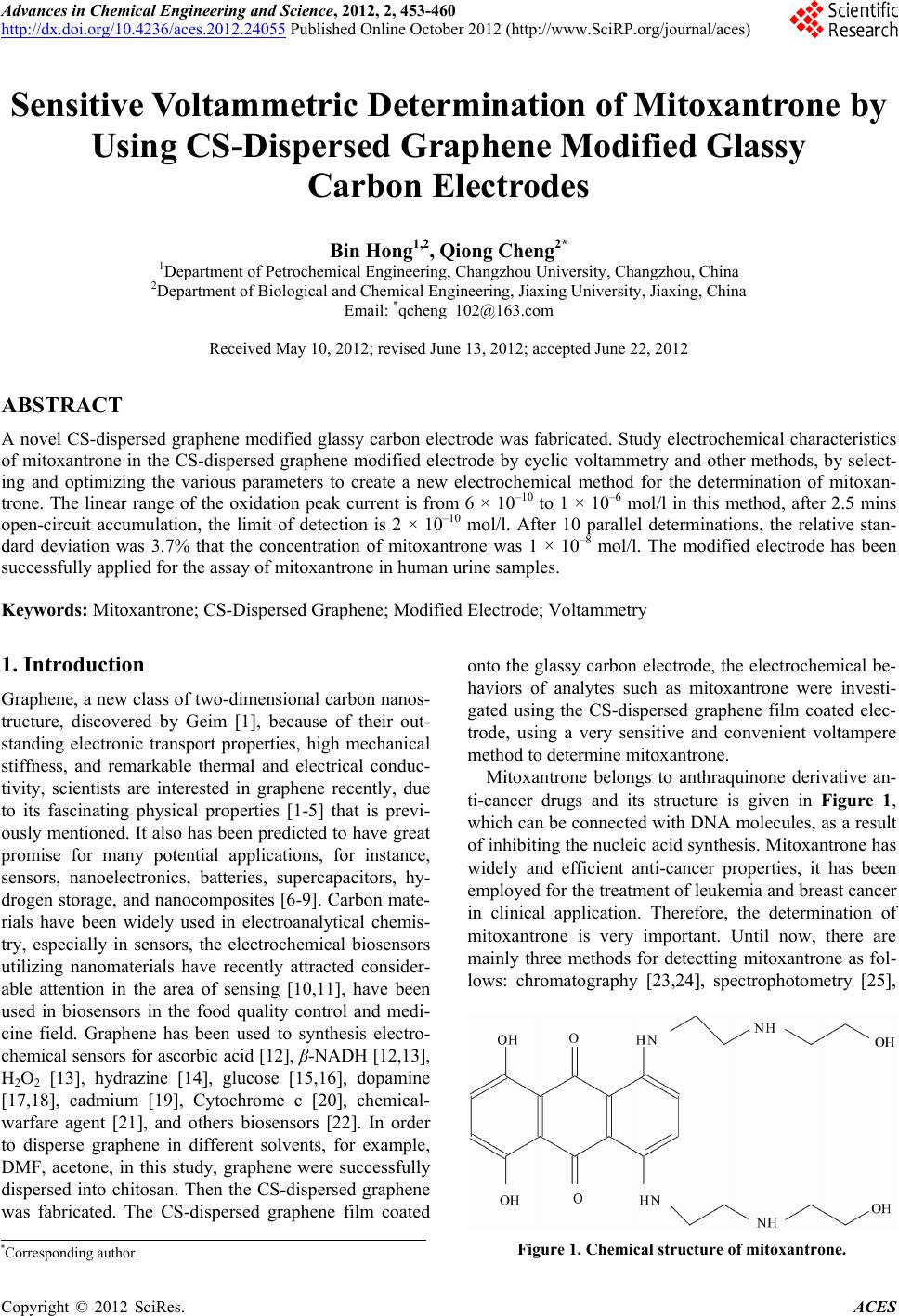 Advances in Chemical Engineering and Science, 2012, 2, 453-460 http://dx.doi.org/10.4236/aces.2012.24055 Published Online October 2012 (http://www.SciRP.org/journal/aces) Sensitive Voltammetric Determination of Mitoxantrone by Using CS-Dispersed Graphene Modified Glassy Carbon Electrodes Bin Hong1,2, Qiong Cheng2* 1Department of Petrochemical Engineering, Changzhou University, Changzhou, China 2Department of Bio logical and Chemical Engineering, Jiaxing University, Jiaxing, China Email: *qcheng_102@163.com Received May 10, 2012; revised June 13, 2012; accepted June 22, 2012 ABSTRACT A novel CS-dispersed graphene modified glassy carbon electrode was fabricated. Study electrochemical characteristics of mitoxantrone in the CS-dispersed graphene modified electrode by cyclic voltammetry and other methods, by select- ing and optimizing the various parameters to create a new electrochemical method for the determination of mitoxan- trone. The linear range of the oxidation peak current is from 6 × 10–10 to 1 × 10–6 mol/l in this method, after 2.5 mins open-circuit accumulation, the limit of detection is 2 × 10–10 mol/l. After 10 parallel determinations, the relative stan- dard deviation was 3.7% that the concentration of mitoxantrone was 1 × 10–8 mol/l. The modified electrode has been successfully applied for the assay of mitoxantrone in human urine samples. Keywords: Mitoxantrone; CS-Dispersed Graphene; Modified Electrode; Voltammetry 1. Introduction Graphene, a new class of two-dimensional carbon nanos- tructure, discovered by Geim [1], because of their out- standing electronic transport properties, high mechanical stiffness, and remarkable thermal and electrical conduc- tivity, scientists are interested in graphene recently, due to its fascinating physical properties [1-5] that is previ- ously mentioned. It also has been predicted to have great promise for many potential applications, for instance, sensors, nanoelectronics, batteries, supercapacitors, hy- drogen storage, and nanocomposites [6-9]. Carbon mate- rials have been widely used in electroanalytical chemis- try, especially in sensors, the electrochemical biosensors utilizing nanomaterials have recently attracted consider- able attention in the area of sensing [10,11], have been used in biosensors in the food quality control and medi- cine field. Graphene has been used to synthesis electro- chemical sensors for ascorbic acid [12], β-NADH [12,13], H2O2 [13], hydrazine [14], glucose [15,16], dopamine [17,18], cadmium [19], Cytochrome c [20], chemical- warfare agent [21], and others biosensors [22]. In order to disperse graphene in different solvents, for example, DMF, acetone, in this study, graphene were successfully dispersed into chitosan. Then the CS-dispersed graphene was fabricated. The CS-dispersed graphene film coated onto the glassy carbon electrode, the electrochemical be- haviors of analytes such as mitoxantrone were investi- gated using the CS-dispersed graphene film coated elec- trode, using a very sensitive and convenient voltampere method to determine mitoxantrone. Mitoxantrone belongs to anthraquinone derivative an- ti-cancer drugs and its structure is given in Figure 1, which can be connected with DNA molecules, as a result of inhibiting the nucleic acid synthesis. Mitox antrone has widely and efficient anti-cancer properties, it has been employed for the treatment of leukemia and breast cancer in clinical application. Therefore, the determination of mitoxantrone is very important. Until now, there are mainly three methods for detectting mitoxantrone as fol- lows: chromatography [23,24], spectrophotometry [25], Figure 1. Chemical structure of mitoxantrone. *Corresponding author. C opyright © 2012 SciRes. ACES  B. HONG, Q. CHENG 454 electrochemical methods [26-29], however, the current methods are not sensitive enough, or equipments are ex- pensive, which are difficult to promote. So we are longed for an effective, quick, inexpensive test method. This study suggests us the new procedure, which is suitted for the detection of mitoxantrone, has some advantages such as ultrasensitivity, rapid response and excellent repro- ducibility. A few years ago, the detection of mitoxan- trone on ion implantation modified electrode had been reported that it had a high limit of detection (1.8 × 10–8 mol/l). But the limit of detection of current methods is lower than that of the reported method. 2. Experimental 2.1. Reagents and Apparatus The mitoxantrone was purchased from South Zhejiang Pharmaceutical Co., Ltd. A 1.0 × 10–4 mol/l standard solution of mitoxantrone was dissolved into H2O and kept in a refrigerator, 0.1mol/l sulfuric acid solution, some working standard solutions were prepared by dilu- tion with water, and all the aqueous solutions were pre- pared with doubly distilled water. Graphite, hydrazine hydrate solution (85 wt%) was purchased from Shanghai Chemical Reagent Co., Ltd. CS-dispersed graphene was fabricated from graphite. Chitosan (from Sinopharm Chemical Reagent Co., Ltd.) solution was prepared by dissolving chitosan in 1% acetic acid solution with mag- netic stirring for 24 h. All the reagents were of analytical grade. A CHI 660A (Shanghai ChenHua Instrument Com- pany) was used for the voltammetric determination, scanning electron microscope (SEM), and a traditional three-electrode system, CS-dispersed graphene modified electrode, a saturated calomel reference electrode and a platinum wire electrode were employed. 2.2. Prepartion of Film Coated CS-Dispersed Graphene GCE The GC electrode was mechanically polished 0.05 µm alumina slurry, then rinsed and sonicated in purified wa- ter, dried in the infrared lamp. The CS-dispersed gra- phene came to form a black suspension by ultrasonica- tion agitation for approximately 2 hours. A certain vol- ume of the CS-dispersed graphene solution was diluted to the appropriate concentration, was dropped onto a GC electrode and the electrode was allowed to dry in room temperature for 24 h to form a CS-graphene modified electrode, noted as CS-GR/GC electrode. Chitosan (CS)/ GC electrode was also constructed as above procedure except graphene in order to compare with the CS-GR/GC electrode. 2.3. Procedure CS-dispersed graphene modified electrode scanned cy- clic voltammograms for several times (scanning range from 0.50 to 0.90 V) in a 4 ml volume of 0.1 mol/l sulfu- ric acid solution until the cyclic voltammograms curves were stable. And added an amount of mitoxantrone stan- dard solution. The scanning range of differential pulse voltammograms from 0.60 to 0.85 V under open-circuit while stirring the for 2.5 mins that were recorded after 15 s quite time, the oxidation peak height was measured at about 0.74 V. After each detection, the CS-dispersed graphene modified electrode scanned cyclic voltammetry in acid solution to remove substance which adsorbed on the electrode surface, as a result of activating electrode. The process of preparation modified electrode which is showed in Figure 2. 3. Results and Discussion 3.1. SEM Characterization of Graphene The morphologies of graphene oxides, graphene were examined by SEM. The typical SEM imagines of gra- phene oxide (A) and the CS-dispersed graphene (B) on the electrode Surface which is showed in Figure 3, re- spectively. The morphology of graphene oxide is granu- lar, but there is a small part of the sheet that can be seen from the Figure 2. However, the most of the CS-dis- persed graphene film is seem to be a flake-like shape which is very different from the former. In addition, the CS-dispersed graphene was fabricated through a simple drop casting method on GCE exhibits a layer structure. 3.2. Electrochemical Responses of Mitoxantrone The voltammetric behavior of mitoxantrone at the bare GCE is investigated using cyclic voltammetry from 0.50 to 0.90 V and the results show that there is no obvious oxidation or reduction responses of mitoxantrone. The voltammetric behavior of mitoxantrone at the CS-dis- persed graphene film coated electrode is also investigated by CV. The CV from 0.50 to 0.90 V of a CS-dispersed graphene film-modified electrode in a pH 1.0 Sulfuric acid solution (without mitox antrone) is shown as curve a in Figure 4, and no observable peak appears. When the concentration of mitoxantrone is 1.0 × 10–6 mol/l, not only appears an oxidation peak at 0.81 V from 0.50 to 0.90 V, but also appears a corresponding reduction peak on the reverse scan at 0.72 V from 0.50 to 0.90 V, sug- gesting that the electrode reaction of mitoxantrone at the CS-dispersed graphene film is possible reversible. The voltammetric responses of mitoxantrone have been compared by differential pulse voltammogram (DPV) which the results are showed in Figure 5. Both bare GCE Figure 5(a)) and chitosan-film coated GCE (Figure ( Copyright © 2012 SciRes. ACES  B. HONG, Q. CHENG Copyright © 2012 SciRes. ACES 455 O HO COOH O COOH HO sulfuric acid potassiu m permanganate Oxidation O HO OH NH 2 O n Reduction Hydrazi ne hy drate O HO OH NH O n CO (A) (B) O OH OH HN O CO n O HO OH NH O n O OH OH HN O n CO CO (B) GCE GCE DPV Mitoxantrone Figure 2. The process of preparation modified electrode A is chitosan, B is CS-dispersed graphene, curve a is a bare GCE, but curve b is a CS-dispersed graphene film coated GCE. 5(b)) are no observable oxidation current when the con- centration of mitoxantrone is 1.0 × 10–8 mol/l. But under the identical conditions, mitoxantrone appears a very significant oxidation signal whose potential is 0.74 V at the CS-dispersed graphene film coated GCE (Figure 5(c)). The significant oxidation peak current is undoubt- edly attributed to characteristics of graphene. These sug- gested that graphene has some special electrochemical properties and big specific surface area which could pro- vide much more reaction sites for the electrochemical oxidation of mitoxantrone, then promote the exchange rates of mitoxantrone, which results in increasing the oxidation peak current greatly. 3.3. Effect of Supporting Electrolyte To optimize the determination conditions of mitoxan- trone, many support electrolytes were also tested, such as HCl, H2SO4, HAc-NaAc, KCl, phosphate buffer, B-R buffer, acetic acid-acetate buffer, others were not as suitable as Sulfuric acid solution for the determination. The pH value of the base solution has an important in- fluence on the oxidation of mitoxantrone at the GCE modified CS-dispersed graphene. The pH effect was stu- died from 0 to 7.0. It showed that the highest oxidation peak current of mitoxantrone was obtained at pH 1.0. Hence, the Sulfuric acid solution pH of 1.0 was support- ing electrolyte for determining mitoxantrone. 3.4. Accumlation Conditions Accumlation conditions can affect the detection sensiti- vity. Accumlation time and accu mlation po tential are two important factors for the accumlation step. The effect on peak current response from accumulation potential and time which is studied by DPV, the concentration of mi- toxantrone used was 1.0 × 10–8 mol/l. When accumulation potential is shifted from +0.5 to –0.5 V, the peak current keep stable. So accumulation at open circuit is adopted. The peak current increases sharply with increasing accumulation time which is illustrated in Figure 6. The value of peak current reaches its maximu m at 2.5 mins, and then levels off. This may be the electrode surface become saturated. Thus, 2.5 mins under open- circuit is generally chosen as accumulation condition. 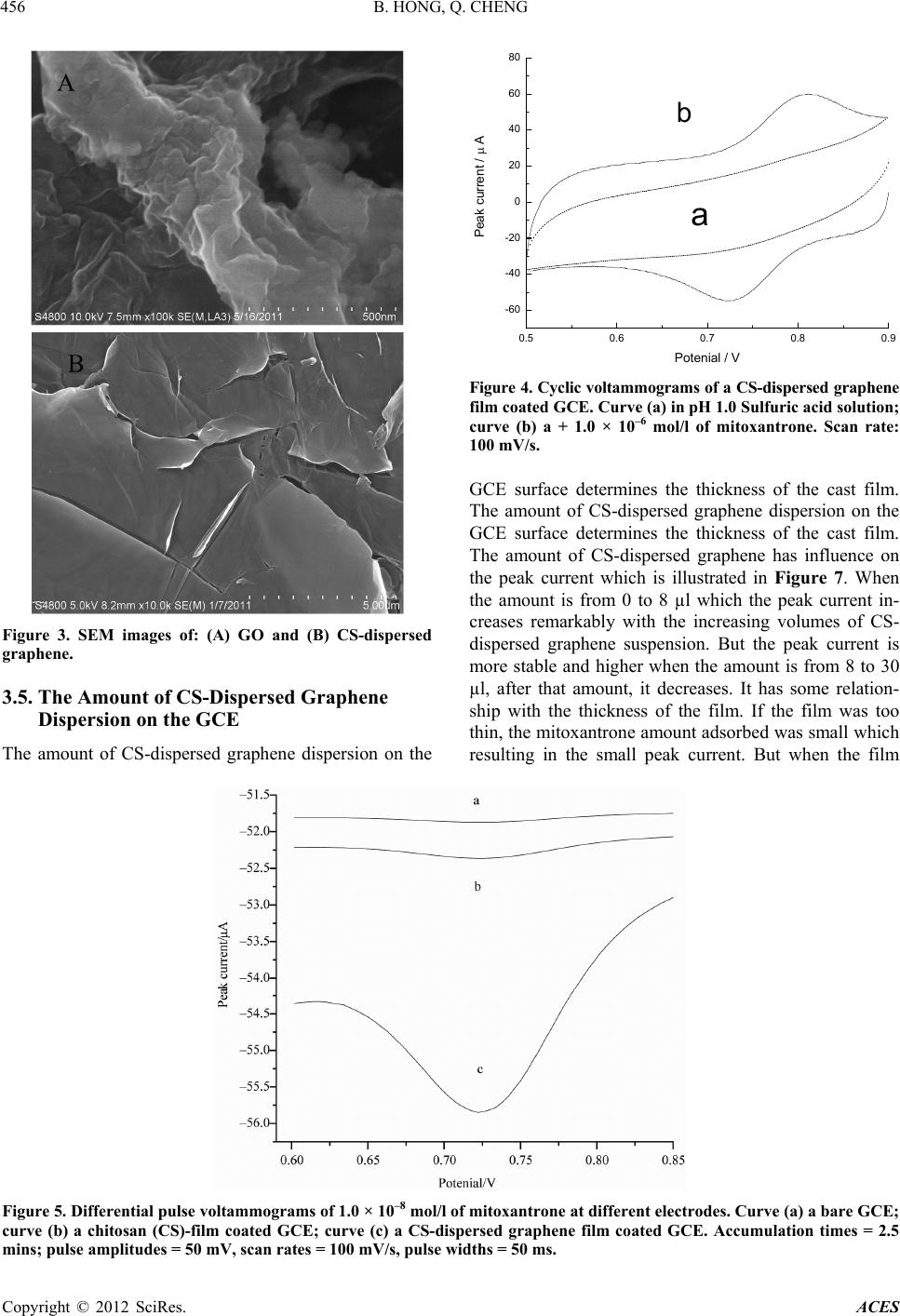 B. HONG, Q. CHENG 456 0.5 0.6 0.7 0.8 0.9 -60 -40 -20 0 20 40 60 80 Peak current / A Potenial / V a b Figure 3. SEM images of: (A) GO and (B) CS-dispersed graphene. 3.5. The Amount of CS-Dispersed Graphene Dispersion on the GCE The amount of CS-dispersed graphene dispersion on the Figure 4. Cyclic voltammograms of a CS-di spersed graphene film coated GCE. Curve (a) in pH 1.0 Sulfuric acid solution; curve (b) a + 1.0 × 10–6 mol/l of mitoxantrone. Scan rate: 100 mV/s. GCE surface determines the thickness of the cast film. The amount of CS-dispersed graphene dispersion on the GCE surface determines the thickness of the cast film. The amount of CS-dispersed graphene has influence on the peak current which is illustrated in Figure 7. When the amount is from 0 to 8 µl which the peak current in- creases remarkably with the increasing volumes of CS- dispersed graphene suspension. But the peak current is more stable and higher when the amount is from 8 to 30 µl, after that amount, it decreases. It has some relation- ship with the thickness of the film. If the film was too thin, the mitoxantrone amount adso rbed was small which resulting in the small peak current. But when the film Figure 5. Differential pulse voltammograms of 1.0 × 10–8 mol/l of mitoxantrone at different electrodes. Curve (a) a bare GCE; curve (b) a chitosan (CS)-film coated GCE; curve (c) a CS-dispersed graphene film coated GCE. Accumulation times = 2.5 mins; pulse amplitudes = 50 mV, scan rates = 100 mV/s, pulse widths = 50 ms. Copyright © 2012 SciRes. ACES 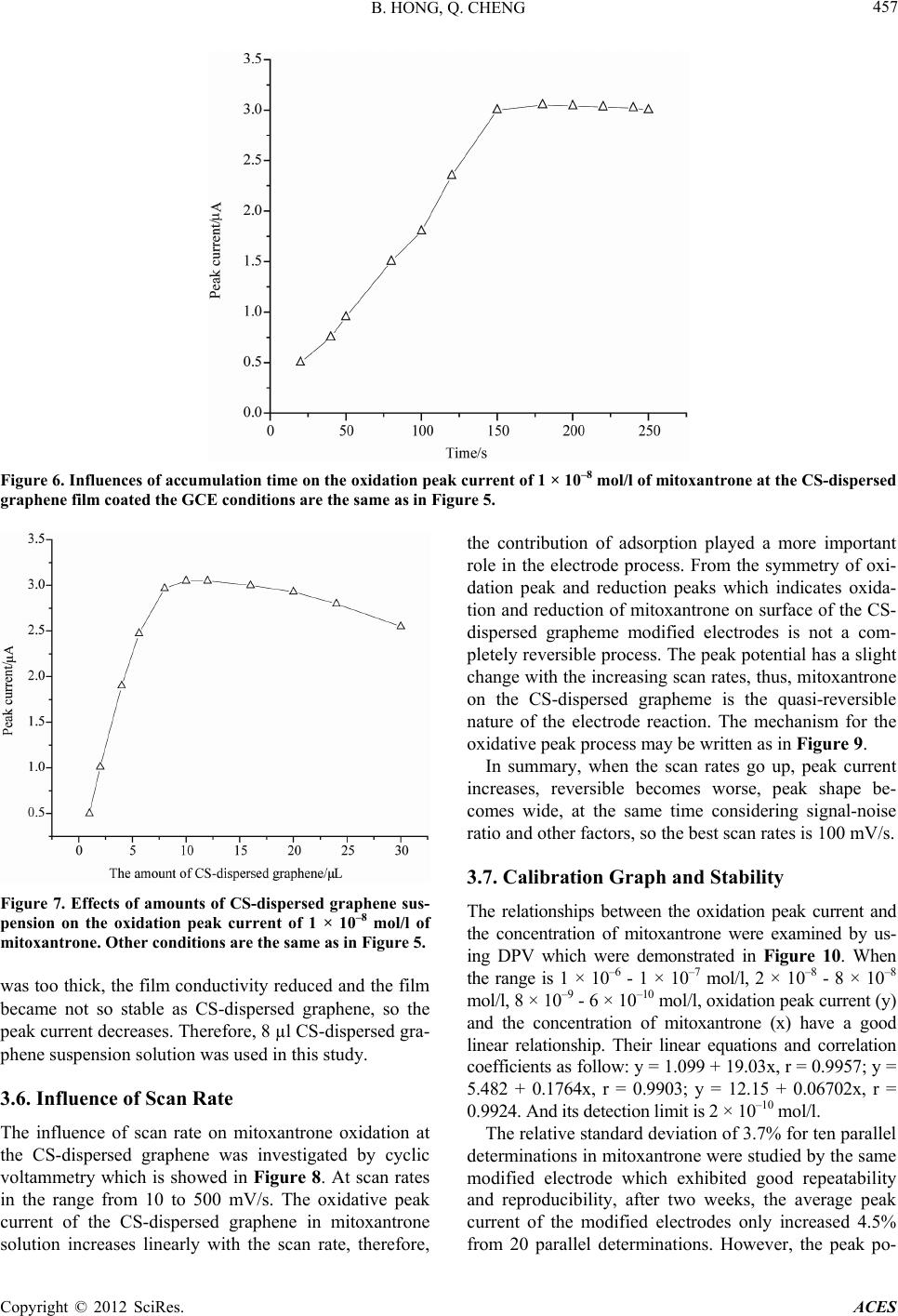 B. HONG, Q. CHENG 457 Figure 6. Influences of accumulation time on the oxidation peak current of 1 × 10–8 mol/l of mitoxantrone at the CS-dispersed graphene film coated the GCE conditions are the same as in Figure 5. Figure 7. Effects of amounts of CS-dispersed graphene sus- pension on the oxidation peak current of 1 × 10–8 mol/l of mitoxantrone. Other conditions are the same as in Figure 5. was too thick, the film conductivity reduced and th e film became not so stable as CS-dispersed graphene, so the peak current decreases. Therefore, 8 µl CS-dispersed gra- phene suspension solution was used in this study. 3.6. Influence of Scan Rate The influence of scan rate on mitoxantrone oxidation at the CS-dispersed graphene was investigated by cyclic voltammetry which is showed in Figure 8. At scan rates in the range from 10 to 500 mV/s. The oxidative peak current of the CS-dispersed graphene in mitoxantrone solution increases linearly with the scan rate, therefore, the contribution of adsorption played a more important role in the electrode process. From the symmetry of oxi- dation peak and reduction peaks which indicates oxida- tion and reduction of mitoxantr one on surface of the CS- dispersed grapheme modified electrodes is not a com- pletely reversible process. The peak potential has a slight change with the increasing scan rates, thus, mitox antrone on the CS-dispersed grapheme is the quasi-reversible nature of the electrode reaction. The mechanism for the oxidative peak process may be written as in Figure 9. In summary, when the scan rates go up, peak current increases, reversible becomes worse, peak shape be- comes wide, at the same time considering signal-noise ratio and other factors, so the best scan rates is 100 mV/s. 3.7. Calibration Graph and Stability The relationships between the oxidation peak current and the concentration of mitoxantrone were examined by us- ing DPV which were demonstrated in Figure 10. When the range is 1 × 10–6 - 1 × 10–7 mol/l, 2 × 10–8 - 8 × 10–8 mol/l, 8 × 10–9 - 6 × 10–10 mol/l, oxidation peak current (y) and the concentration of mitoxantrone (x) have a good linear relationship. Their linear equations and correlation coefficients as follow: y = 1.099 + 19.03x, r = 0.9957; y = 5.482 + 0.1764x, r = 0.9903; y = 12.15 + 0.06702x, r = 0.9924. And its dete cti on limit is 2 × 10–10 m ol/l. The relative standard d eviation of 3.7% for ten p arallel determinations in mitoxantrone were studied by the same modified electrode which exhibited good repeatability and reproducibility, after two weeks, the average peak current of the modified electrodes only increased 4.5% from 20 parallel determinations. However, the peak po- Copyright © 2012 SciRes. ACES 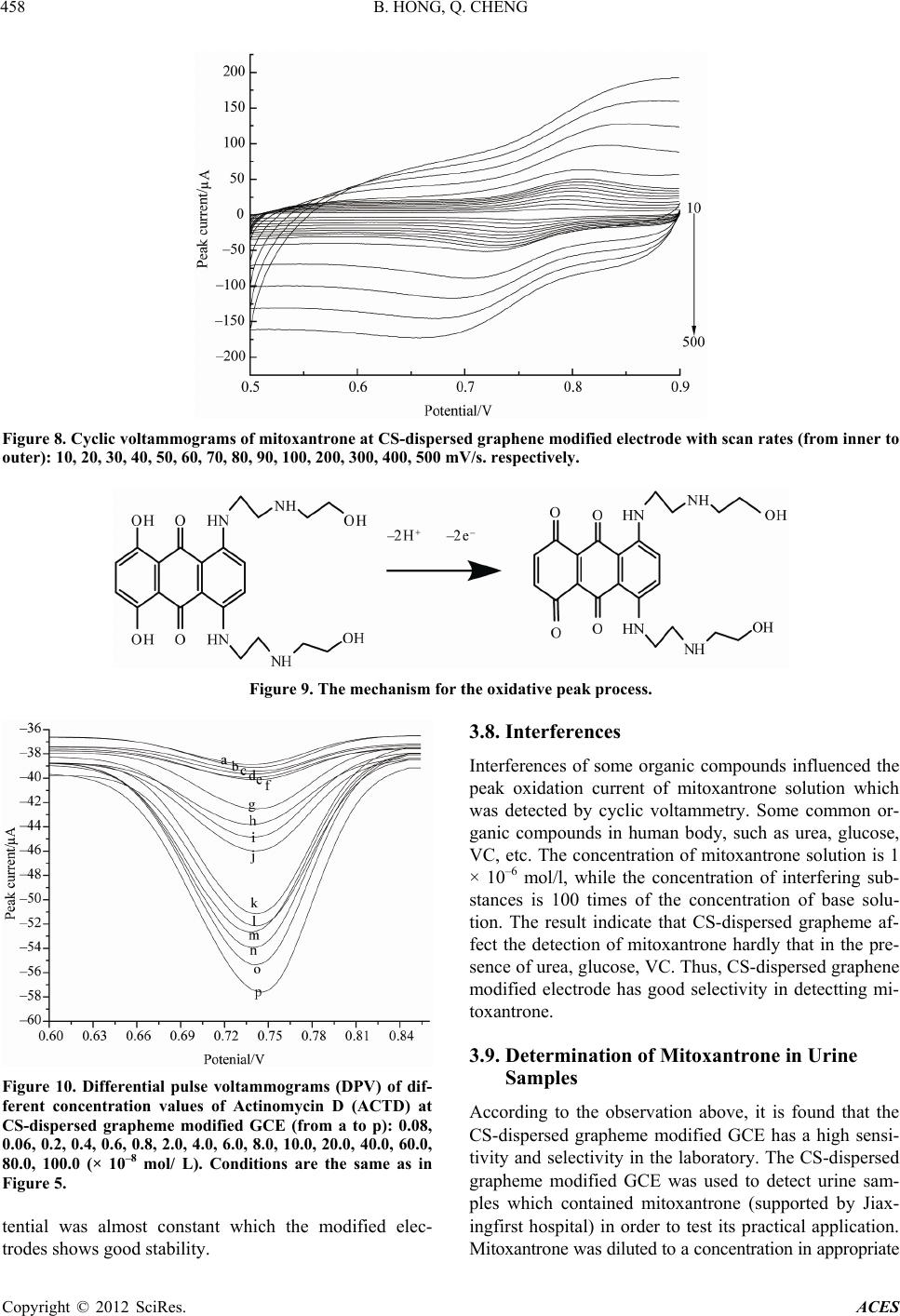 B. HONG, Q. CHENG 458 Figure 8. Cyclic voltammograms of mitoxantrone at CS-dispersed graphene modified electrode with scan rates (from inner to outer): 10, 20, 30, 40, 50, 60, 70, 80, 90, 100, 200, 300, 400, 500 mV/s. respectively. Figure 9. The mechanism for the oxidative peak process. Figure 10. Differential pulse voltammograms (DPV) of dif- ferent concentration values of Actinomycin D (ACTD) at CS-dispersed grapheme modified GCE (from a to p): 0.08, 0.06, 0.2, 0.4, 0.6, 0.8, 2.0, 4.0, 6.0, 8.0, 10.0, 20.0, 40.0, 60.0, 80.0, 100.0 (× 10–8 mol/ L). Conditions are the same as in Figure 5. tential was almost constant which the modified elec- trodes shows good stability. 3.8. Interferences Interferences of some organic compounds influenced the peak oxidation current of mitoxantrone solution which was detected by cyclic voltammetry. Some common or- ganic compounds in human body, such as urea, glucose, VC, etc. The concentration of mitoxantrone solution is 1 × 10–6 mol/l, while the concentration of interfering sub- stances is 100 times of the concentration of base solu- tion. The result indicate that CS-dispersed grapheme af- fect the detection of mitoxantrone hardly that in the pre- sence of urea, glucose, VC. Thus, CS-dispersed graphene modified electrode has good selectivity in detectting mi- toxantrone. 3.9. Determination of Mitoxantrone in Urine Samples According to the observation above, it is found that the CS-dispersed grapheme modified GCE has a high sensi- tivity and selectivity in the laboratory. The CS-dispersed grapheme modified GCE was used to detect urine sam- ples which contained mitoxantrone (supported by Jiax- ingfirst hospital) in order to test its practical application. Mitoxantrone was diluted to a concentration in appropriate Copyright © 2012 SciRes. ACES 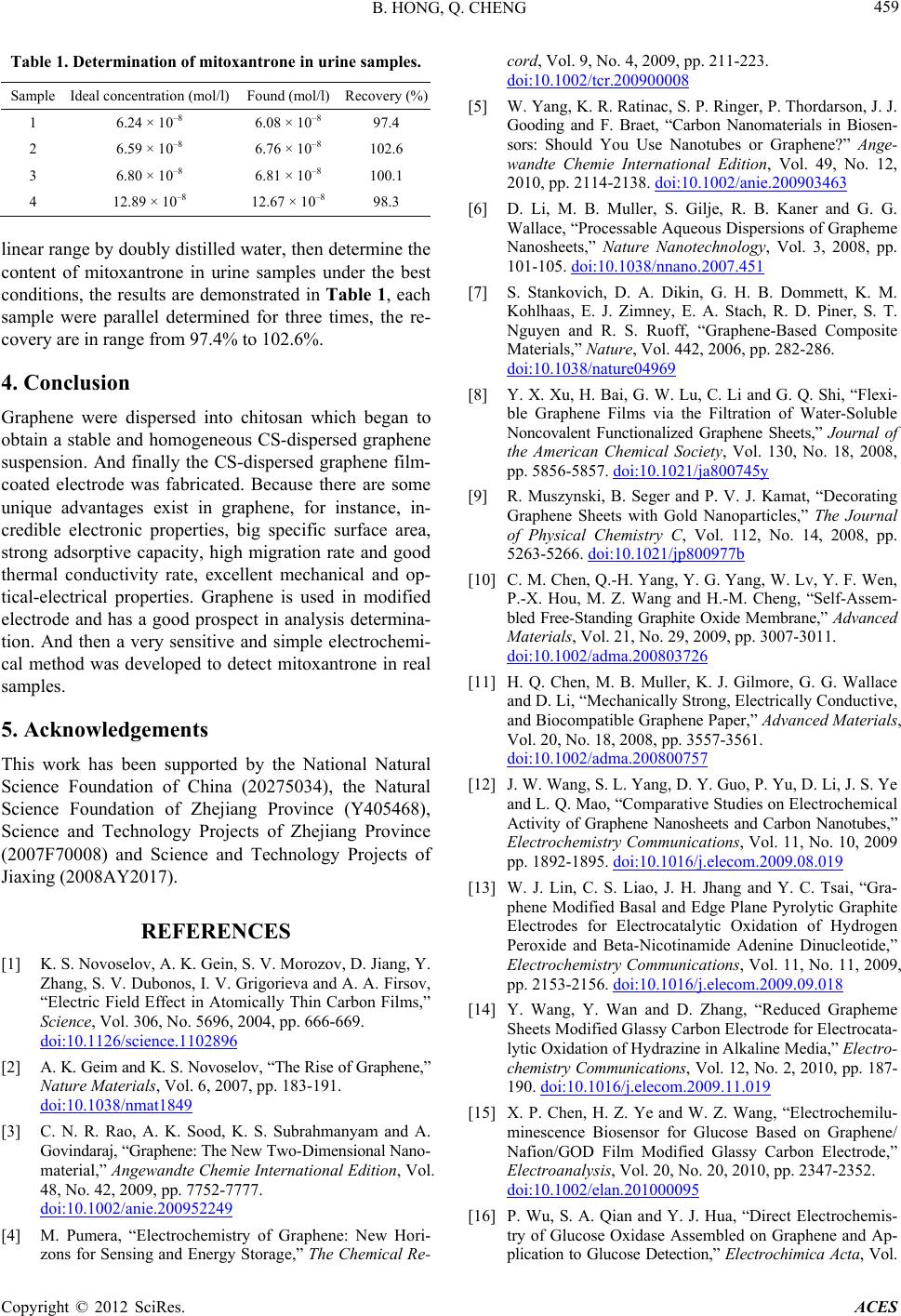 B. HONG, Q. CHENG 459 Table 1. Determination of mitoxantrone in urine samples. Sample Ideal concentration (mol/l)Found (mol/l) Recovery (%) 1 6.24 × 10–8 6.08 × 10–8 97.4 2 6.59 × 10–8 6.76 × 10–8 102.6 3 6.80 × 10–8 6.81 × 10–8 100.1 4 12.89 × 10–8 12.67 × 10–8 98.3 linear range by doubly d istilled water, then determine the content of mitoxantrone in urine samples under the best conditions, the results are demonstrated in Table 1, each sample were parallel determined for three times, the re- covery are in range from 97.4% to 102.6%. 4. Conclusion Graphene were dispersed into chitosan which began to obtain a stable and homogeneous CS-dispersed graphene suspension. And finally the CS-dispersed graphene film- coated electrode was fabricated. Because there are some unique advantages exist in graphene, for instance, in- credible electronic properties, big specific surface area, strong adsorptive capacity, high migration rate and good thermal conductivity rate, excellent mechanical and op- tical-electrical properties. Graphene is used in modified electrode and has a good prospect in analysis determina- tion. And then a very sensitive and simple electrochemi- cal method was developed to detect mitoxantrone in real samples. 5. Acknowledgements This work has been supported by the National Natural Science Foundation of China (20275034), the Natural Science Foundation of Zhejiang Province (Y405468), Science and Technology Projects of Zhejiang Province (2007F70008) and Science and Technology Projects of Jiaxing (2008AY2017). REFERENCES [1] K. S. Novoselov, A. K. Gein, S. V. Morozov, D. Jiang, Y. Zhang, S. V. Dubonos, I. V. Grigorieva and A. A. Firsov, “Electric Field Effect in Atomically Thin Carbon Films,” Science, Vol. 306, No. 5696, 2004, pp. 666-669. doi:10.1126/science.1102896 [2] A. K. Geim and K. S. Nov osel ov, “The Ri se of Graphene,” Nature Materials, Vol. 6, 2007, pp. 183-191. doi:10.1038/nmat1849 [3] C. N. R. Rao, A. K. Sood, K. S. Subrahmanyam and A. Govindaraj, “Graphene: The New Two-Dimension al Nano- material,” Angewandte Chemie International Edition, Vol. 48, No. 42, 2009, pp. 7752-7777. doi:10.1002/anie.200952249 [4] M. Pumera, “Electrochemistry of Graphene: New Hori- zons for Sensing and Energy Storage,” The Chemical Re- cord, Vol. 9, No. 4, 2009, pp. 211-223. doi:10.1002/tcr.200900008 [5] W. Yang, K. R. Ratinac, S. P. Ringer, P. Thordarson, J. J. Gooding and F. Braet, “Carbon Nanomaterials in Biosen- sors: Should You Use Nanotubes or Graphene?” Ange- wandte Chemie International Edition, Vol. 49, No. 12, 2010, pp. 2114-2138. doi:10.1002/anie.200903463 [6] D. Li, M. B. Muller, S. Gilje, R. B. Kaner and G. G. Wallace, “Processable Aqueous Dispersions of Grapheme Nanosheets,” Nature Nanotechnology, Vol. 3, 2008, pp. 101-105. doi:10.1038/nnano.2007.451 [7] S. Stankovich, D. A. Dikin, G. H. B. Dommett, K. M. Kohlhaas, E. J. Zimney, E. A. Stach, R. D. Piner, S. T. Nguyen and R. S. Ruoff, “Graphene-Based Composite Materials,” Nature, Vol. 442, 2006, pp. 282-286. doi:10.1038/nature04969 [8] Y. X. Xu, H. Bai, G. W. Lu, C. Li and G. Q. Shi, “Flexi- ble Graphene Films via the Filtration of Water-Soluble Noncovalent Functionalized Graphene Sheets,” Journal of the American Chemical Society, Vol. 130, No. 18, 2008, pp. 5856-5857. doi:10.1021/ja800745y [9] R. Muszynski, B. Seger and P. V. J. Kamat, “Decorating Graphene Sheets with Gold Nanoparticles,” The Journal of Physical Chemistry C, Vol. 112, No. 14, 2008, pp. 5263-5266. doi:10.1021/jp800977b [10] C. M. Chen, Q.-H. Yang, Y. G. Yang, W. Lv, Y. F. Wen, P.-X. Hou, M. Z. Wang and H.-M. Cheng, “Self-Assem- bled Free-Standing Graphite Oxide Membrane,” Advanced Materials, Vol. 21, No. 29, 2009, pp. 3007-3011. doi:10.1002/adma.200803726 [11] H. Q. Chen, M. B. Muller, K. J. Gilmore, G. G. Wallace and D. Li, “Mechanically Strong, Electrically Conductive, and Biocompatible Graphene Paper,” Advanced Materials, Vol. 20, No. 18, 2008, pp. 3557-3561. doi:10.1002/adma.200800757 [12] J. W. Wang, S. L. Yang, D. Y. Guo, P. Yu, D. Li, J. S. Ye and L. Q. Mao, “Comparative Studies on Electrochemical Activity of Graphene Nanosheets and Carbon Nanotubes,” Electrochemistry Communications, Vol. 11, No. 10, 2009 pp. 1892-1895. doi:10.1016/j.elecom.2009.08.019 [13] W. J. Lin, C. S. Liao, J. H. Jhang and Y. C. Tsai, “Gra- phene Modified Basal and Edge Plane Py rolytic Graphite Electrodes for Electrocatalytic Oxidation of Hydrogen Peroxide and Beta-Nicotinamide Adenine Dinucleotide,” Electrochemistry Communications, Vol. 11, No. 11, 2009, pp. 2153-2156. doi:10.1016/j.elecom.2009.09.018 [14] Y. Wang, Y. Wan and D. Zhang, “Reduced Grapheme Sheets Modified Glassy Carbon Ele ct ro de for Elec tr ocata- lytic Oxidation of Hydrazine in Alkaline Media,” Electro- chemistry Communications, Vol. 12, No. 2, 2010, pp. 187- 190. doi:10.1016/j.elecom.2009.11.019 [15] X. P. Chen, H. Z. Ye and W. Z. Wang, “Electrochemilu- minescence Biosensor for Glucose Based on Graphene/ Nafion/GOD Film Modified Glassy Carbon Electrode,” Electroanalysis, Vol. 20, No. 20, 2010, pp. 2347-2352. doi:10.1002/elan.201000095 [16] P. Wu, S. A. Qian and Y. J. Hua, “Direct Electrochemis- try of Glucose Oxidase Assembled on Graphene and Ap- plication to Glucose Detection,” Electrochimica Acta, Vol. Copyright © 2012 SciRes. ACES  B. HONG, Q. CHENG Copyright © 2012 SciRes. ACES 460 55, No. 28, 2010, pp. 8606-8614. doi:10.1016/j.electacta.2010.07.079 [17] Y. Wang, Y. M. Li and L. H. Tang, “Application of Gra- phene-Modified Electrode for Selective Detection of Do- pamine,” Electrochemistry Communications, Vol. 11, No. 4, 2009, pp. 889-892. doi:10.1016/j.elecom.2009.02.013 [18] L. Tan, K.-G. Zhou, Y. H. Zhang, et al., “Nanomolar Detection of Dopamine in the Presence of Ascorbic Acid at Beta-Cyclodextrin/Graphene Nanocomposite Platform,” Electrochemistry Communications, Vol. 12, No. 4, 2010, pp. 557-560. doi:10.1016/j.elecom.2010.01.042 [19] J. Li, S. J. Guo and Y. M. Zhai, “Nafion-Graphene Nano- composite Film as Enhanced Sensing Platform for Ultra- sensitive Determination of Cadmium,” Electrochemistry Communications, Vol. 11, No. 5, 2009, pp. 1085-1088. doi:10.1016/j.elecom.2009.03.025 [20] J.-F. Wu, M.-Q. Xu and G.-C. Zhao, “Graphene-Based Modified Electrode for the Direct Electron Transfer of Cytochrome c and Biosensing,” Electrochemistry Com- munications, Vol. 12, No. 1, 2010, pp. 175-177. doi:10.1016/j.elecom.2009.11.020 [21] J. T. Robinson, F. K. Perkins, E. S. Snow, Z. Wei and P. E. Sheehan, “Reduced Graphene Oxide Molecular Sen- sors,” Nano Letters, Vol. 8, No. 10, 2008, pp. 3137-3140. doi:10.1021/nl8013007 [22] M. Zhou, Y. M. Zhai and S. J. Dong, “Electrochemical Sensing and Biosensing Platform Based on Chemically Reduced Graphene Oxide,” Analytical Chemistry, Vol. 81, No. 14, 2009, pp. 5603-5613. doi:10.1021/ac900136z [23] K. M. Rentsch, R. A. Schwendener and E. Hänseler, “Determination of Mitoxant rone in Mouse Whole Blood and Different Tissues by High-Performance Liquid Chro- matography,” Journal of Chromatography B: Biomedical Sciences and Applications, Vol. 679, No. 1-2, 1996, pp. 185-192. doi:10.1016/0378-4347(96)00023-0 [24] P. Guo, L. M. Ye, W. Z. Wu and T. S. Wu, “Determina- tion of Antitumour Drug Mitoxantrone in Plasma Using HPLC Column Switching Technique,” Acta Pharmaceu- tica Sinica, Vol. 26, No. 5, 1991, pp. 367-369. [25] Q. Z. Zhou, C. Y. Wu, L. K. Zhang, N. Li and X. Y. He, “Determination of Mitoxantrone by Spectrophotometry,” Chinese Journal of Pharmaceutical Analysis, Vol. 17, No. 6, 1997, pp. 403-405. [26] H. Z. Song, M. F. Yang and Z. Y. Gu, “Adsorptive Behav- iour of Mitoxantrone and Its Adsorptive Voltammeteic Determination,” Chinese Journal of Analytical Chemistry, Vol. 21, 1993, pp. 1285-1287. [27] M. D. Guo, “Study on Mitoxantrone Using Mercury Film Carbon Fiber Microelectrode by 1.5 Order Differential Stripping Voltammetry,” Chinese Analytical Sciences Acta, Vol. 11, 1995, pp. 46-48. [28] J. B. Hu and Q. L. Li, “Studies on the Voltammetric Be- havior of Mitoxantrone and Its Application at the Ni/GC Modified Electrode,” Chemical Journal of Chinese Uni- versities, Vol. 22, No. 3, 2001, pp. 380-384. [29] M. O. Brett, T. R. A.Macedo, D. Raimundo, M. H. Mar- ques and S. H. P. Serrano, “Electrochemical Oxidation of Mitoxantrone at a Glassy Carbon Electrode,” Analytica Chimica Acta, Vol. 385, No. 1-3, 1999, pp. 401-408. doi:10.1016/S0003-2670(98)00807-1
|